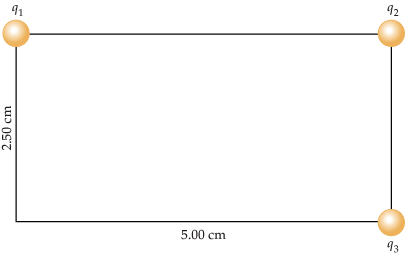The diagram shows the electric field lines surrounding three electric charges. Assume that q1 + q2...
The diagram shows the electric field lines
surrounding three electric charges.
Assume that q1 +
q2 = -2.36
Homework Answers
|Fe|= (k*|q1|*|q2|)/r^2
|E|=(k*|Q|)/r^2
k = 8.99*10^9 (N*m^2)/C^2
Fe = Electrostatic force between a pair of charges
r = charge separation
q1, q2 = charge magnitudes
E = electric field
Q = charged object
Have you learned Gauss's Law/Maxwell's first equation yet? This problem is essentially that. It involves the fact that electric field lines begin on positive charges, and end on negative charges. So the number of electric field lines around a certain charge distribution is proportional to the net amount of charge in that distribution. If you look at the diagram, you have twice as many field lines entering q2 as you have leaving q1 and q3. Using that, what can you determine about the signs and magnitudes of the charges?
Not the answer you're looking for?
Similar Questions
Charges q1=3q and q2=7q are a distance L apart. a) Calculate the electric field of q1...
The figure shows three charges q1, q2 and q3 situated at corners of a rectangle of...
What is the electric field magnitude midway between charges of Q1 = 3 C and Q2...
How Can I solve this problem? Three charges, q1= -10 μC, q2= 4 μC and q3=...
Three point charges q1, q2, and q3 are situated at three corners of a rectangle as...
 Three point charges q1, q2, and q3 are situated at three corners
of a rectangle as shown in the diagram below. Here q1 = +9.00 µC,
q2 = −9.00 µC, q3 = +2.00 µC.
https://www.webassign.net/webassignalgphys1/19-p-026.gif
(a) What is the electric potential at the free corner where
there is no charge? V
(b) What charge should be placed at the free corner for the
electric potential at the center of the rectangle to be zero?
Include both magnitude and sign if...
Three point charges q1, q2, and q3 are situated at three corners
of a rectangle as shown in the diagram below. Here q1 = +9.00 µC,
q2 = −9.00 µC, q3 = +2.00 µC.
https://www.webassign.net/webassignalgphys1/19-p-026.gif
(a) What is the electric potential at the free corner where
there is no charge? V
(b) What charge should be placed at the free corner for the
electric potential at the center of the rectangle to be zero?
Include both magnitude and sign if...There are three charges at positions, q1 = (0.0m, 0.0m), q2 = (1.5m, 0.0m), q3 =...
Three electric charges of values q1 = 1muc, q2 = 4muc, q3 = -2muc, are located...
In the diagram below, the two charges q1 = +q and q2 = −2q are fixed...
1. Find the resultant electric field at the origin, due to Q1 and Q2. origin =...
What is the electric field generated at point M by the two charges shown below? Q1...
Need Online Homework Help?
Get Answers For Free
Most questions answered within 1 hours.
Active Questions
asked 3 minutes ago
asked 7 minutes ago
asked 9 minutes ago
asked 36 minutes ago
asked 38 minutes ago
asked 59 minutes ago
asked 1 hour ago
asked 1 hour ago
asked 1 hour ago
asked 1 hour ago
asked 1 hour ago
asked 1 hour ago